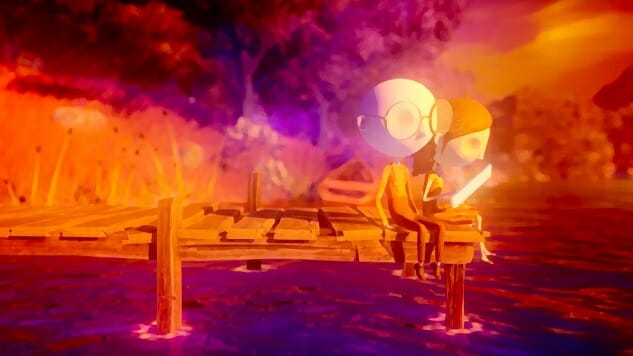Spoiler Warning: This piece contains spoilers for both Last Day of June and Twin Peaks: The Return.
I wouldn’t add Last Day of June to our list of games influenced by Twin Peaks—when you get past a few elements of magic realism and some timeline rewinding, Ovosonico’s new work is a relatively straight-forward and earthbound story—but playing it the day after the TV show’s finale aired made it impossible to not compare the two. Both have similar conclusions, although with opposite statements, as two well-meaning men try to save the lives of young women who have perished. Dale Cooper’s failure to rescue Laura Palmer shows how grief and loss can’t be undone, even if you can bend the space-time continuum to make it happen. Last Day of June is explicitly about undoing the tragedy that drives the entire story. That direction robs Last Day of June of what power it might have had, turning grief from an experience to be endured into another videogame challenge to be conquered.
A woman dies in a car crash at the start of Last Day of June. Her husband, now alone and in a wheelchair, awakens one night to find her paintings glowing with mystical energy. By examining those paintings, and exploring their small village, the husband can relive the chain reaction of events that lead to the wreck, briefly taking control of four neighbors and trying to coordinate their actions to prevent the accident. In the process the game also reveals details about the couple’s marriage and the miscarriage they suffered. As the player, I guide the husband and his four neighbors through those fateful moments multiple times, trying to put each one in the right place at the right time to keep that car from spinning off the road.
I expected a depressing end. I hoped Last Day of June would show how foolish the husband was being, how futile his attempts to undo the past and nullify his grief were. For a moment, the game seems headed in that direction: after finally hitting on the right formula, and removing every possible cause of the wreck from the scene, the husband awakes with hope that he has saved his wife. Instead he finds his wheelchair by the side of his recliner, his house still dark and empty. He destroys her paintings in a sorrowful rage. That was the ending I had hoped for, because it would have been an honest one, one that understood the weight of loss and that didn’t undercut the grief at the heart of the story. It would be an ending like the one found in Twin Peaks: The Return.
It’s not how the game ends, though. The husband makes one final attempt and succeeds in saving his wife. He even somehow undoes the miscarriage. In the process he has to sacrifice himself, so it’s not an entirely happy ending, but it ends with both his wife and his previously unborn son enjoying the same sunlit lake that the couple visits earlier in the game. It’s depicted as a noble sacrifice, one that erases both tragedies that befell his family. It’s impossible to feel sad about that.
It’s also very difficult to feel comfortable with this. There’s nothing wrong with happy endings, but Last Day of June’s narrative strength is its depiction of grief. Without dialogue, the characters remain shallow sketches, and what resonance the game has comes from the wordless, aching chasm of the husband’s sorrow. By letting him undo that trauma, the game trivializes the idea of loss, irredeemably diminishing itself in the process. It’s a story about grief that ultimately runs from it, saying nothing useful or insightful about it in the process. This decision guarantees that the entire game fades quickly out of view, like the memories that flicker as the husband wheels through the village at night, and like the spirits that float in and out of Twin Peaks.
Garrett Martin edits Paste’s games and comedy sections. He’s on Twitter @grmartin.
